Driving Force Analysis of Agricultural Economic Growth Related to Water Utilization Effects Based on LMDI Method in Ningxia, Northwest China
Abstract
:1. Introduction
2. Materials and Methods
2.1. Study Area
2.2. Data Description
2.3. Extended Kaya Identity
2.4. LDI Methodology
3. Results and Discussion
3.1. Changes in Agricultural Production Value and Their Driving Factors
3.2. Analysis of the Driving Factors of Agricultural Production Value in Ningxia
3.2.1. Effect of Agriculture Water Efficiency
3.2.2. Effect of Water Utilization Structure
3.2.3. Effect of Water Stress
3.2.4. Effect of Water Resource Endowment
3.2.5. Population Effect
3.3. Analysis on the Driving Factors of Agricultural Production Value in Each City
3.3.1. Additive Decomposition
3.3.2. Multiplicative Decomposition
3.3.3. Potential Causes and Implications of Spatial Difference
4. Conclusions
Author Contributions
Funding
Conflicts of Interest
References
- Zhang, F.; Zhan, J.; Li, Z.; Jia, S.; Chen, S. Impacts of urban transformation on water footprint and sustainable energy in Shanghai, China. J. Clean. Prod. 2018, 190, 847–853. [Google Scholar] [CrossRef]
- Li, Z.; Deng, X.; Jin, G.; Mohmmed, A.; Arowolo, A.O. Tradeoffs between agricultural production and ecosystem services: A case study in Zhangye, Northwest China. Sci. Total Environ. 2020, 707, 136032. [Google Scholar] [CrossRef] [PubMed]
- Ma, L.; Long, H.; Tang, L.; Tu, S.; Zhang, Y.; Qu, Y. Analysis of the spatial variations of determinants of agricultural production efficiency in China. Comput. Electron. Agric. 2021, 180, 105890. [Google Scholar] [CrossRef]
- Lin, J.Y. Rural Reforms and Agricultural Growth in China. Am. Econ. Rev. 1992, 82, 34–51. [Google Scholar]
- Chen, P.; Yu, M.; Chang, C.; Hsu, S. Total factor productivity growth in China’s agricultural sector. China Econ. Rev. 2008, 19, 580–593. [Google Scholar] [CrossRef]
- Guo, P.; Yu, K.; Huang, Y. Changes and Decomposition of Agricultural TFP Regional Disparities in China: Study of F(a)re-Primont TFP Index. Econ. Geogr. 2013, 33, 143–147. [Google Scholar]
- Richey, A.S.; Thomas, B.F.; Lo, M.; Famiglietti, J.S.; Swenson, S.; Rodell, M. Uncertainty in global groundwater storage estimates in a Total Groundwater Stress framework. Water Resour. Res. 2015, 51, 5198–5216. [Google Scholar] [CrossRef]
- Fischer, G.; Tubiello, F.N.; van Velthuizen, H.; Wiberg, D.A. Climate change impacts on irrigation water requirements: Effects of mitigation, 1990–2080. Technol. Soc. 2007, 74, 1083–1107. [Google Scholar] [CrossRef] [Green Version]
- Galán-Martín, Á.; Vaskan, P.; Antón, A.; Esteller, L.J.; Guillén-Gosálbez, G. Multi-objective optimization of rainfed and irrigated agricultural areas considering production and environmental criteria: A case study of wheat production in Spain. J. Clean. Prod. 2017, 140, 816–830. [Google Scholar] [CrossRef]
- Rosegrant, M.; Ringler, C.; Zhu, T. Water for Agriculture: Maintaining Food Security Under Growing Scarcity. Annu. Rev. Environ. Resour. 2009, 34, 205–222. [Google Scholar] [CrossRef]
- Fan, L.; Liu, G.; Wang, F.; Ritsema, C.J.; Geissen, V. Domestic Water Consumption under Intermittent and Continuous Modes of Water Supply. Water Resour. Manag. 2014, 28, 853–865. [Google Scholar] [CrossRef]
- Hu, Z.; Chen, Y.; Yao, L.; Wei, C.; Li, C. Optimal allocation of regional water resources: From a perspective of equity–efficiency tradeoff. Resour. Conserv. Recycl. 2016, 109, 102–113. [Google Scholar] [CrossRef]
- Levidow, L.; Zaccaria, D.; Maia, R.; Vivas, E.; Todorovic, M.; Scardigno, A. Improving water-efficient irrigation: Prospects and difficulties of innovative practices. Agric. Water Manag. 2014, 146, 84–94. [Google Scholar] [CrossRef] [Green Version]
- Jiang, Y.; Xu, X.; Huang, Q.; Huo, Z.; Huang, G. Optimizing regional irrigation water use by integrating a two-level optimization model and an agro-hydrological model. Agric. Water Manag. 2016, 178, 76–88. [Google Scholar] [CrossRef] [Green Version]
- Pandey, R.K.; Maranville, J.W.; Admou, A. Deficit irrigation and nitrogen effects on maize in a Sahelian environment: I. Grain yield and yield components. Agric. Water Manag. 2000, 46, 1–13. [Google Scholar] [CrossRef]
- Viswanatha, G.B.; Ramachandrappa, B.K.; Nanjappa, H.V. Soil–plant water status and yield of sweet corn (Zea mays L. cv. Saccharata) as influenced by drip irrigation and planting methods. Agric. Water Manag. 2002, 55, 85–91. [Google Scholar] [CrossRef]
- Alrwis, K.N.; Ghanem, A.M.; Alnashwan, O.S.; Al Duwais, A.A.M.; Alaagib, S.A.B.; Aldawdahi, N.M. Measuring the impact of water scarcity on agricultural economic development in Saudi Arabia. Saudi J. Biol. Sci. 2021, 28, 191–195. [Google Scholar] [CrossRef]
- Wang, W.; Hu, P.; Wang, J.; Zhao, J.; Liu, H.; Yang, Z. Scenario analysis for the sustainable development of agricultural water in the Wuyuer River basin based on the WEP model with a reservoir and diversion engineering module. Sci. Total Environ. 2021, 758, 143668. [Google Scholar] [CrossRef]
- Li, M.; Xu, Y.; Fu, Q.; Singh, V.P.; Liu, D.; Li, T. Efficient irrigation water allocation and its impact on agricultural sustainability and water scarcity under uncertainty. J. Hydrol. 2020, 586, 124888. [Google Scholar] [CrossRef]
- Ang, B.W.; Choi, K.H. Decomposition of Aggregate Energy and Gas Emission Intensities for Industry: A Refined Divisia Index Method. Energy J. 1997, 18, 59–73. [Google Scholar] [CrossRef]
- Ang, B.W.; Zhang, F.Q.; Choi, K. Factorizing changes in energy and environmental indicators through decomposition. Energy 1998, 23, 489–495. [Google Scholar] [CrossRef]
- Liu, L.; Fan, Y.; Wu, G.; Wei, Y. Using LMDI method to analyze the change of China’s industrial CO2 emissions from final fuel use: An empirical analysis. Energy Policy 2007, 35, 5892–5900. [Google Scholar] [CrossRef]
- Zhang, W.; Xu, Y.; Wang, C.; Streets, D.G. Assessment of the driving factors of CO2 mitigation costs of household biogas systems in China: A LMDI decomposition with cost analysis model. Renew. Energy 2022, 181, 978–989. [Google Scholar] [CrossRef]
- Timma, L.; Zoss, T.; Blumberga, D. Life after the financial crisis. Energy intensity and energy use decomposition on sectorial level in Latvia. Appl. Energy 2016, 162, 1586–1592. [Google Scholar] [CrossRef]
- Zhao, C.; Chen, B. Driving force analysis of the agricultural water footprint in China based on the LMDI method. Environ. Sci. Technol. 2014, 48, 12723–12731. [Google Scholar] [CrossRef]
- Liu, Y.; Lin, J.; Li, H.; Huang, R.; Han, H. Driving Forces of Food Consumption Water Footprint in North China. Water 2021, 13, 810. [Google Scholar] [CrossRef]
- Zhao, X.; Tillotson, M.R.; Liu, Y.W.; Guo, W.; Yang, A.H.; Li, Y.F. Index decomposition analysis of urban crop water footprint. Ecol. Model. 2017, 348, 25–32. [Google Scholar] [CrossRef] [Green Version]
- Shi, C.; Wang, Y.; Zhang, C.; Zhang, L. Spatial-Temporal Differences in Water Footprints of Grain Crops in Northwest China: LMDI Decomposition Analysis. Water 2019, 11, 2457. [Google Scholar] [CrossRef] [Green Version]
- Mahony, T.O. Decomposition of Ireland’s carbon emissions from 1990 to 2010: An extended Kaya identity. Energy Policy 2013, 59, 573–581. [Google Scholar] [CrossRef] [Green Version]
- Ortega-Ruiz, G.; Mena-Nieto, A.; García-Ramos, J.E. Is India on the right pathway to reduce CO2 emissions? Decomposing an enlarged Kaya identity using the LMDI method for the period 1990–2016. Sci. Total Environ. 2020, 737, 139638. [Google Scholar] [CrossRef]
- Wu, Q.; Zuo, Q.; Ma, J.; Zhang, Z.; Jiang, L. Evolution analysis of water consumption and economic growth based on Decomposition-Decoupling Two-stage Method: A case study of Xinjiang Uygur Autonomous Region, China. Sustain. Cities Soc. 2021, 75, 103337. [Google Scholar] [CrossRef]
- Fu, T.; Xu, C.; Yang, L.; Hou, S.; Xia, Q. Measurement and driving factors of grey water footprint efficiency in Yangtze River Basin. Sci. Total Environ. 2022, 802, 149587. [Google Scholar] [CrossRef]
- Shao, S.; Yang, L.; Gan, C.; Cao, J.; Geng, Y.; Guan, D. Using an extended LMDI model to explore techno-economic drivers of energy-related industrial CO2 emission changes: A case study for Shanghai (China). Renew. Sustain. Energy Rev. 2016, 55, 516–536. [Google Scholar] [CrossRef] [Green Version]
- Zhang, S.; Su, X.; Singh, V.P.; Ayantobo, O.O.; Xie, J. Logarithmic Mean Divisia Index (LMDI) decomposition analysis of changes in agricultural water use: A case study of the middle reaches of the Heihe River basin, China. Agric. Water Manag. 2018, 208, 422–430. [Google Scholar] [CrossRef]
- Wang, F.; Yu, C.; Xiong, L.; Chang, Y. How can agricultural water use efficiency be promoted in China? A spatial-temporal analysis. Resour. Conserv. Recycl. 2019, 145, 411–418. [Google Scholar] [CrossRef]
- Azad, M.A.S.; Ancev, T. Measuring environmental efficiency of agricultural water use: A Luenberger environmental indicator. J. Environ. Manag. 2014, 145, 314–320. [Google Scholar] [CrossRef] [PubMed]
- Veettil, P.C.; Speelman, S.; van Huylenbroeck, G. Estimating the Impact of Water Pricing on Water Use Efficiency in Semi-arid Cropping System: An Application of Probabilistically Constrained Nonparametric Efficiency Analysis. Water Resour. Manag. 2013, 27, 55–73. [Google Scholar] [CrossRef]
- Sun, Y.; Liu, N.; Shang, J.; Zhang, J. Sustainable utilization of water resources in China: A system dynamics model. J. Clean. Prod. 2017, 142, 613–625. [Google Scholar] [CrossRef]
- Kumar, M.D.; van Dam, J.C. Drivers of change in agricultural water productivity and its improvement at basin scale in developing economies. Water Int. 2013, 38, 312–325. [Google Scholar] [CrossRef]
- Cai, X.; Rosegrant, M.W. Optional water development strategies for the Yellow River Basin: Balancing agricultural and ecological water demands. Water Resour. Res. 2004, 40, W08S04. [Google Scholar] [CrossRef] [Green Version]
- Falkenmark, M.; Lundqvist, J.; Widstrand, C. Macro-scale water scarcity requires micro-scale approaches. Nat. Resour. Forum 1989, 13, 258–267. [Google Scholar] [CrossRef]
- Liu, X.; Shen, Y.; Guo, Y.; Li, S.; Guo, B. Modeling demand/supply of water resources in the arid region of northwestern China during the late 1980s to 2010. J. Geogr. Sci. 2015, 25, 573–591. [Google Scholar] [CrossRef]
- Munia, H.; Guillaume, J.H.A.; Mirumachi, N.; Porkka, M.; Wada, Y.; Kummu, M. Water stress in global transboundary river basins: Significance of upstream water use on downstream stress. Environ. Res. Lett. 2016, 11, 14002. [Google Scholar] [CrossRef]
- Chen, Y.; Zhang, Z.; Tao, F. Impacts of climate change and climate extremes on major crops productivity in China at a global warming of 1.5 and 2.0 °C. Earth Syst. Dyn. 2018, 9, 543–562. [Google Scholar] [CrossRef] [Green Version]
- Su, T.; Feng, G. Spatial-temporal variation characteristics of global evaporation revealed by eight reanalyses. Sci. China Earth Sci. 2015, 58, 255–269. [Google Scholar] [CrossRef]
- Zhang, Y.; Zhang, B.; Liu, Y.; Zhang, D.; Zhou, D. Spatial and Temporal Pattern of Strong Drought and Its Influence Factors in Ningxia from 1960–2012. J. Catastrophology 2016, 31, 120–127. [Google Scholar]
- Du, J.; Yang, Z.; Wang, H.; Yang, G.; Li, S. Spatial–Temporal Matching Characteristics between Agricultural Water and Land Resources in Ningxia, Northwest China. Water 2019, 11, 1460. [Google Scholar] [CrossRef] [Green Version]
- Cai, X.; Rosegrant, M.W.; Ringler, C. Physical and economic efficiency of water use in the river basin: Implications for efficient water management. Water Resour. Res. 2003, 39, 1013. [Google Scholar] [CrossRef]
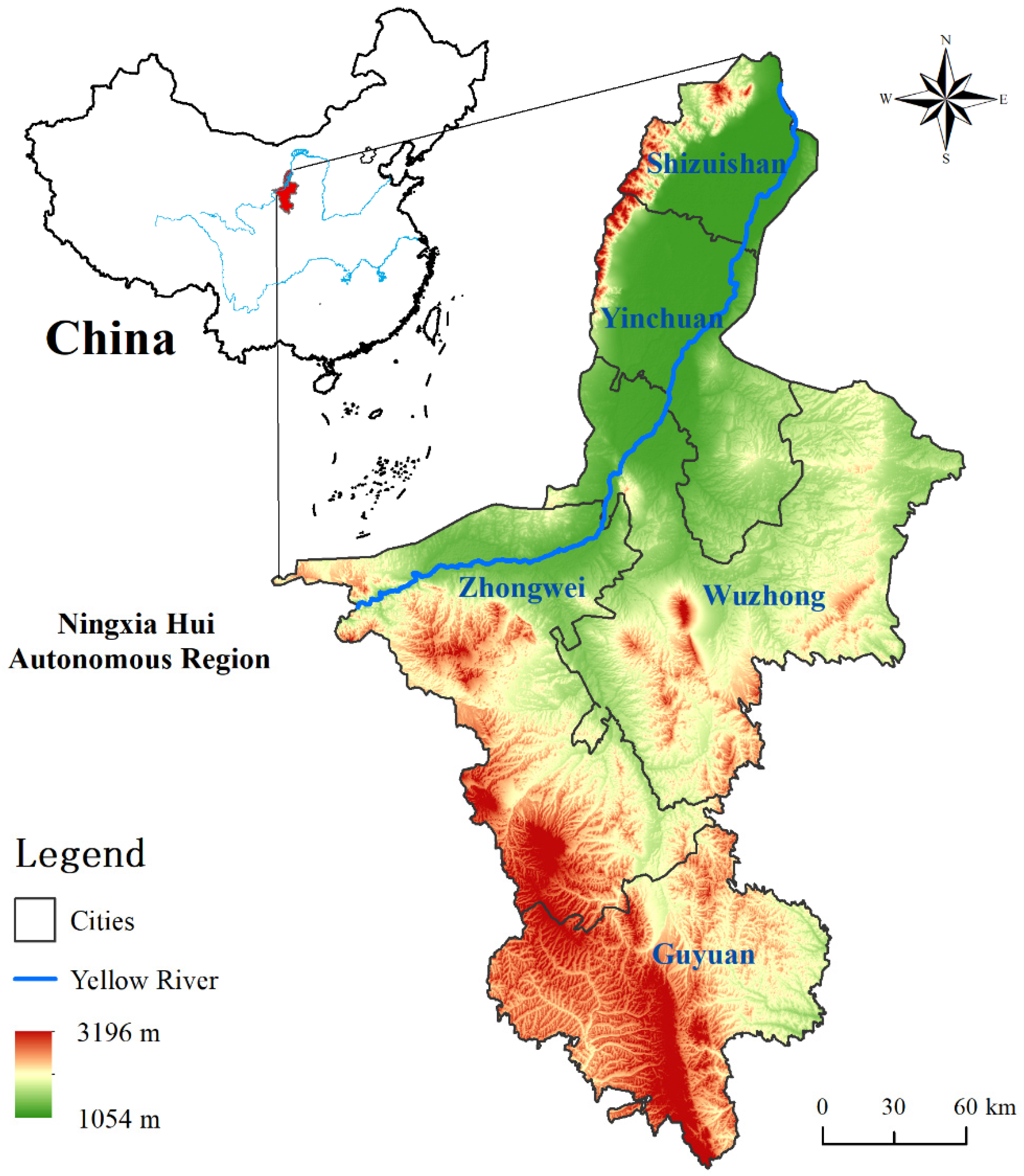
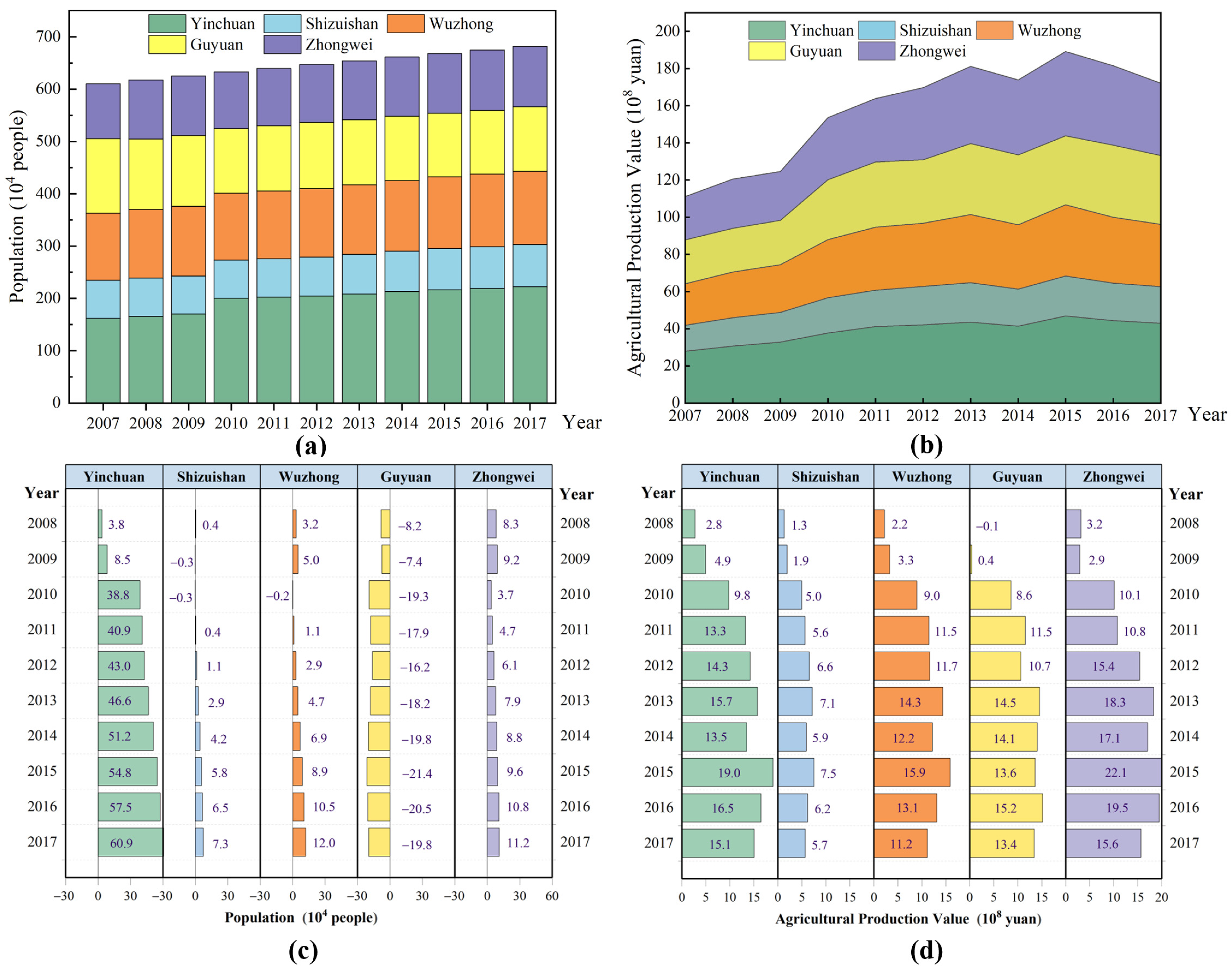
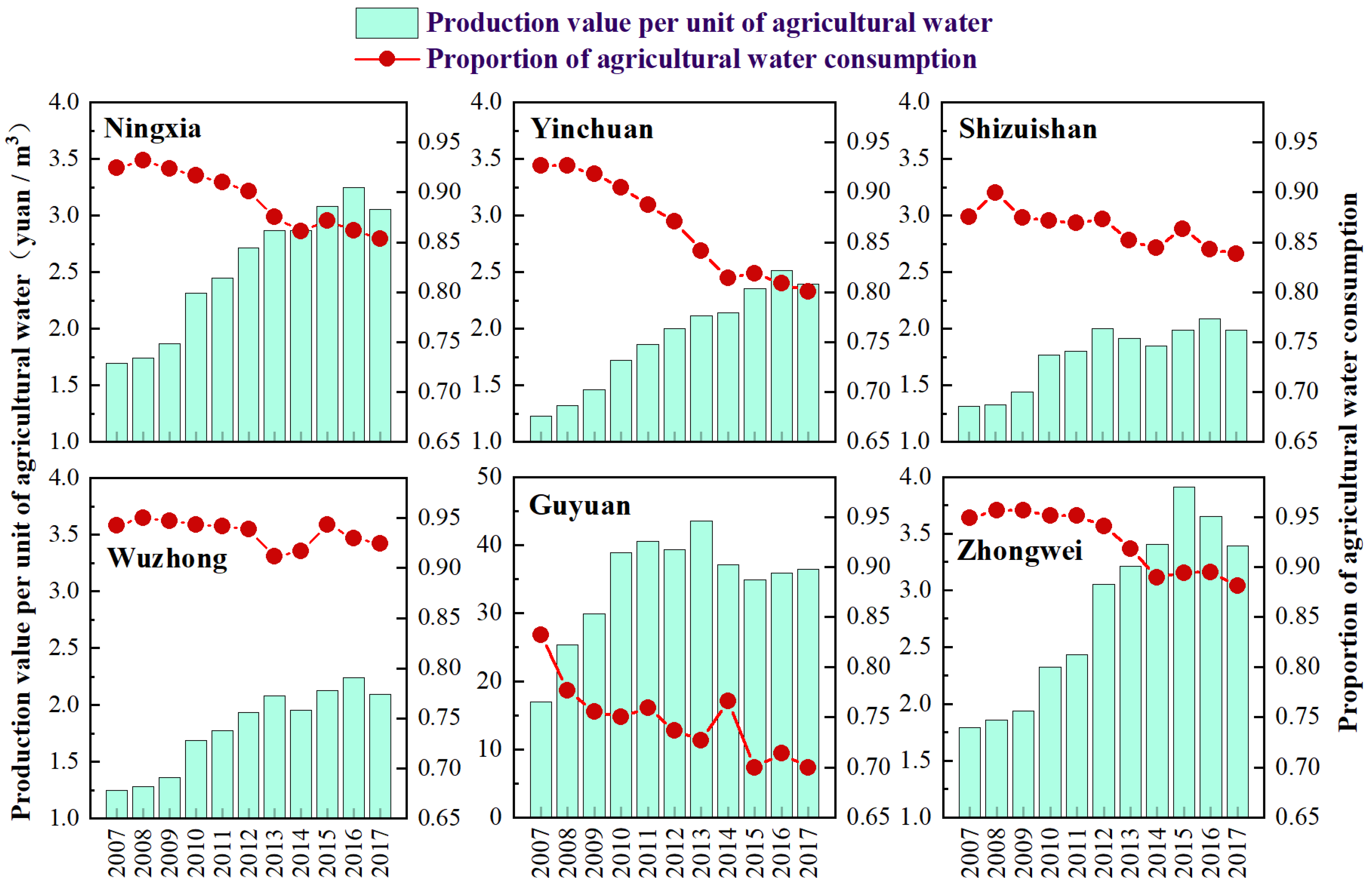

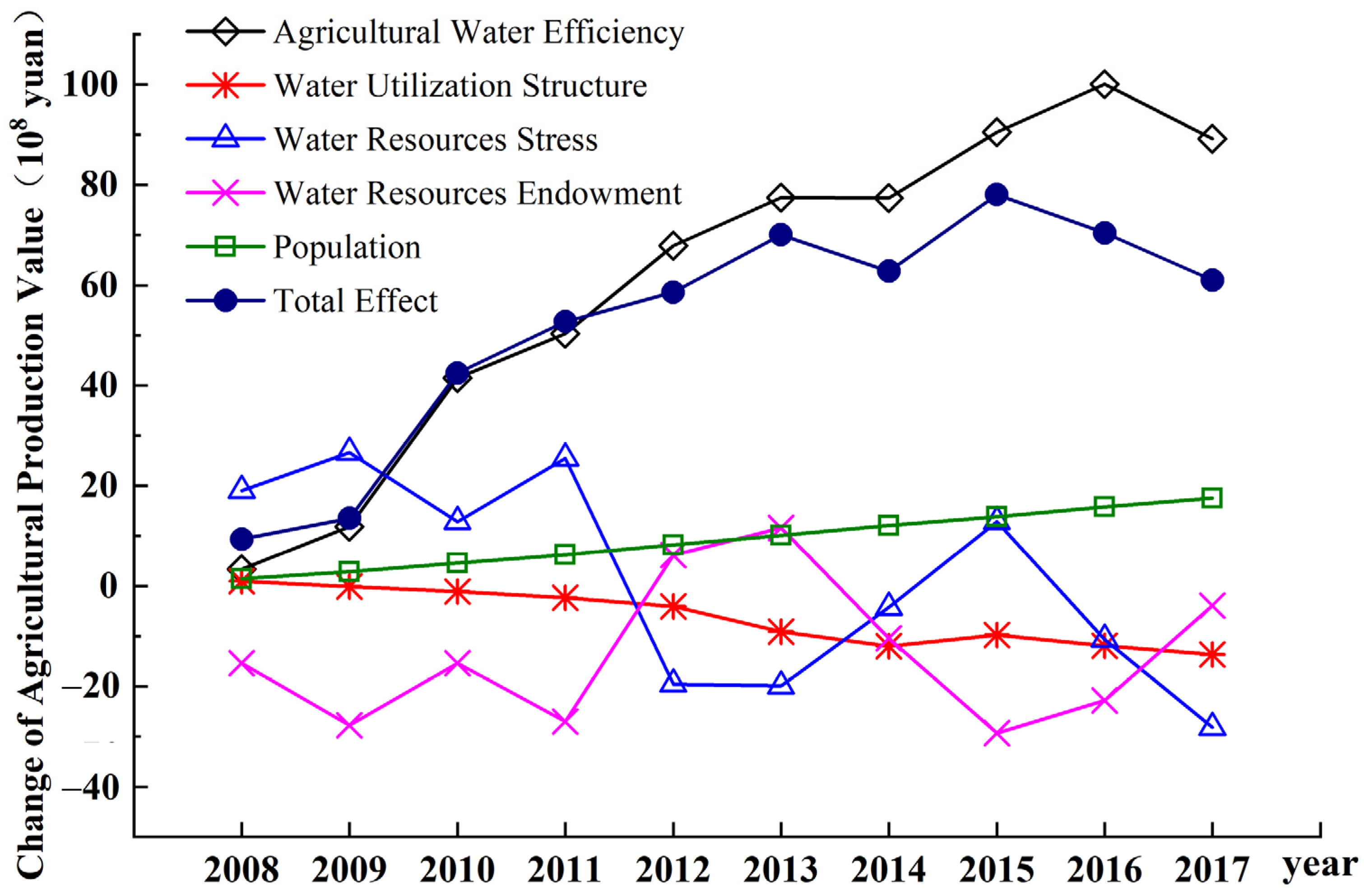
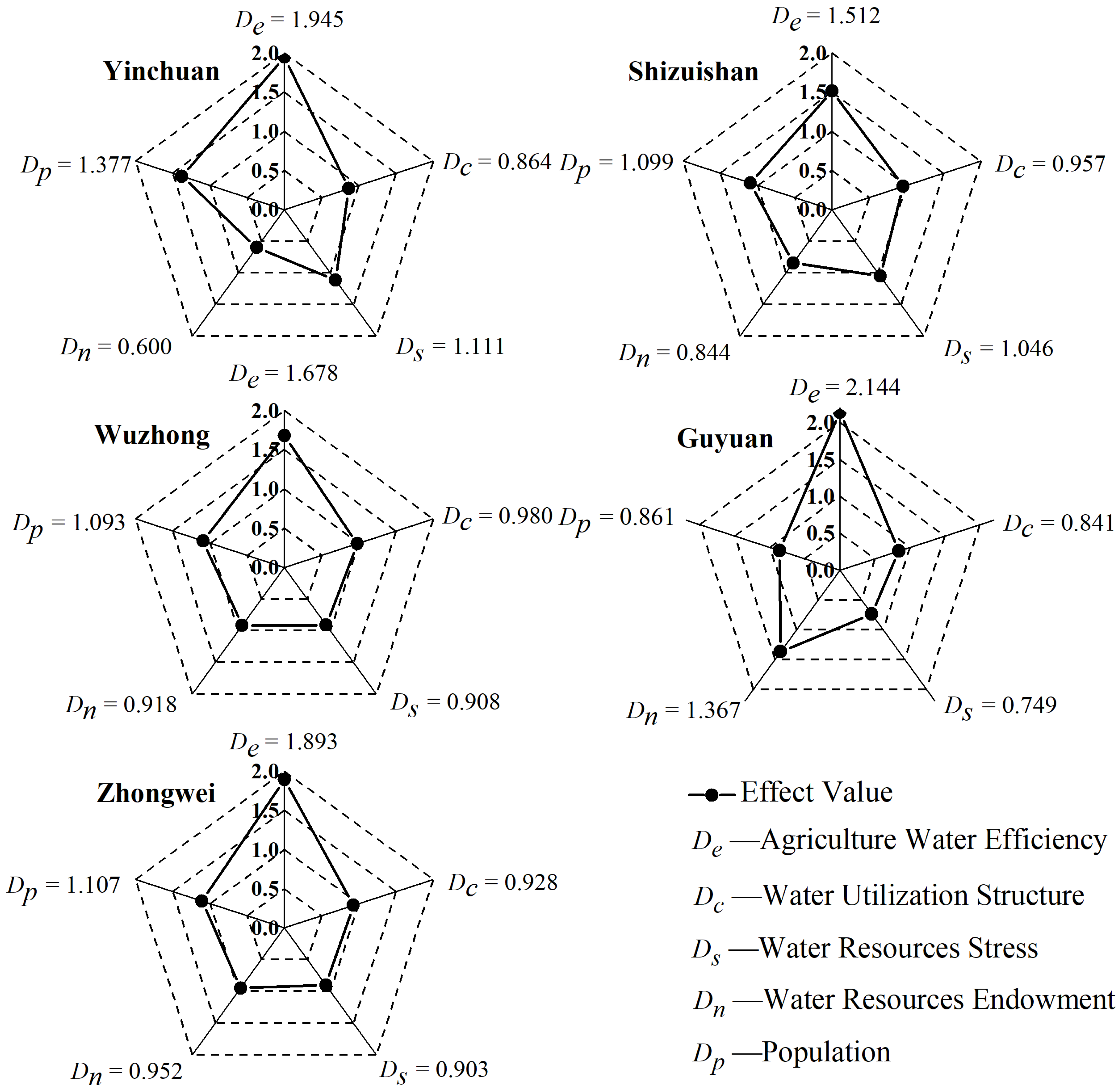
| Year | Total Effect | |||||
|---|---|---|---|---|---|---|
| 2007~2008 | 3.344 | 0.949 | 19.035 | −15.374 | 1.403 | 9.358 |
| 2008~2009 | 8.479 | −1.091 | 7.639 | −12.374 | 1.480 | 4.134 |
| 2009~2010 | 29.684 | −0.985 | −13.810 | 12.363 | 1.708 | 28.960 |
| 2010~2011 | 8.830 | −1.197 | 12.656 | −11.631 | 1.621 | 10.279 |
| 2011~2012 | 17.525 | −1.724 | −45.072 | 33.138 | 2.005 | 5.872 |
| 2012~2013 | 9.595 | −5.066 | −0.401 | 5.440 | 1.888 | 11.455 |
| 2013~2014 | −0.094 | −2.878 | 15.689 | −21.975 | 1.982 | −7.276 |
| 2014~2015 | 13.129 | 2.241 | 17.117 | −18.942 | 1.731 | 15.275 |
| 2015~2016 | 9.512 | −2.161 | −23.494 | 6.550 | 1.937 | −7.656 |
| 2016~2017 | −10.837 | −1.710 | −17.525 | 18.878 | 1.796 | −9.398 |
| Accumulative Value | 89.168 | −13.623 | −28.165 | −3.927 | 17.551 | 61.004 |
| City | Total Effect | |||||
|---|---|---|---|---|---|---|
| Yinchuan | 25.027 | −5.978 | 0.751 | −16.536 | 11.810 | 15.073 |
| 166% | −40% | 5% | −110% | 78% | 100% | |
| Shizuishan | 7.367 | −0.913 | 0.546 | −3.261 | 1.957 | 5.696 |
| 129% | −16% | 10% | −57% | 34% | 100% | |
| Wuzhong | 15.816 | −0.709 | −5.929 | −1.006 | 2.980 | 11.153 |
| 142% | −6% | −53% | −9% | 27% | 100% | |
| Guyuan | 17.924 | −4.984 | −6.707 | 11.222 | −4.017 | 13.438 |
| 133% | −37% | −50% | 84% | −30% | 100% | |
| Zhongwei | 21.554 | −3.036 | −5.877 | −0.275 | 3.278 | 15.644 |
| 138% | −19% | −38% | −2% | 21% | 100% |
Publisher’s Note: MDPI stays neutral with regard to jurisdictional claims in published maps and institutional affiliations. |
© 2021 by the authors. Licensee MDPI, Basel, Switzerland. This article is an open access article distributed under the terms and conditions of the Creative Commons Attribution (CC BY) license (https://creativecommons.org/licenses/by/4.0/).
Share and Cite
Du, J.; Yang, Z.; Yang, G.; Li, S.; Luo, Z. Driving Force Analysis of Agricultural Economic Growth Related to Water Utilization Effects Based on LMDI Method in Ningxia, Northwest China. Water 2021, 13, 3639. https://doi.org/10.3390/w13243639
Du J, Yang Z, Yang G, Li S, Luo Z. Driving Force Analysis of Agricultural Economic Growth Related to Water Utilization Effects Based on LMDI Method in Ningxia, Northwest China. Water. 2021; 13(24):3639. https://doi.org/10.3390/w13243639
Chicago/Turabian StyleDu, Jie, Zhaohui Yang, Guiyu Yang, Shuoyang Li, and Ziteng Luo. 2021. "Driving Force Analysis of Agricultural Economic Growth Related to Water Utilization Effects Based on LMDI Method in Ningxia, Northwest China" Water 13, no. 24: 3639. https://doi.org/10.3390/w13243639





